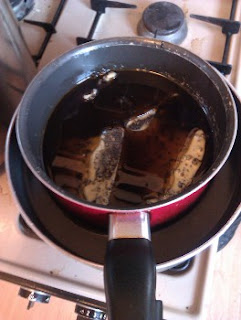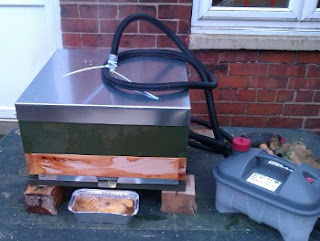So fruit and mead... I was swapping a tin of beewax furniture polish for a box of apples. I'd made apple sauce with the previous box but this time I decided to try making an apple Melomel. Whilst waiting for the apples I went and bought yeast, pectolase and a few other bits I figured I'd need. I no longer had enough honey for the mead, gave most of it away lol, so on my way home popped into a supermarket to buy some more. Whilst there I spotted half price cranberries. So on a whim I bought them and decided to make a Cranberry Melomel, relegating the Apple Melomel for another day and another post. As with the mead I concocted my own recipe based on the many existing recipes floating about on the internet adapted to what was available to me. The fruit can be added before or after the primary fermentation, which ever you use affects the final flavour in different ways. I opted to add the fruit right at the start because it just sounded easier.
I purchased a kilo of cranberries but only used 500g having noticed people seem to be using less cranberry than they used other fruits. Going by other recipes I'm still using quite a lot of cranberries for the volume I'm making.
 |
| This lot will become a Cranberry Melomel |
Cranberry Melomel Ingredients
1.36 KG Honey -four jars of Tesco's cheapest is adequate I reckon
1 tsp yeast nutrient
1 pack of yeast
500g Cranberries
2.292 Kg sugar (I was going to use 2KG but had a bag to finish off)
One teabag
Packet of yeast
1/4 teaspoon of yeast nutrient
5 litres of water -I didn't use all five, when the demijohn's full enough just stop adding it -this isn't rocket science...
1 teaspoon of pectolase
I boiled up the cranberries with the sugar in some of the water in one pan and in another heated some more of the water with the honey to dissolve it. To get as much honey as I could from the jars after pouring them into the pan I filled them with water and left them a while before pouring that out into the pan with the too. I also steeped a teabag in a little water whilst this was going on. The more surface area of the fruit available the better so once the cranberries had softened I got out my hand blender, dipped it in and turned it on to liquidise them.
 |
| Blending the Cranberries -WTF? Another picure without any bees in it!? |
That done and all the honey dissolved in the other pan I ladled the contents of both pans into the demijohn via a funnel along with the tea I'd made. To help mix it all up I alternated a ladle of one with a ladle of the other. Then after letting it cool enough that it hopefully wouldn't kill the yeast I poured a little water into a bowl, warmed it in the microwave briefly then dropped the yeast and a teaspoon of yeast nutrient into it along with a teaspoon of pectolase. -Cranberries are high in pectin and pectolase is an enzyme that breaks this down. Gave it a shake to mix it all up, slapped in a bung and airlock then sat the demijohn to ferment out of the way. It looks like a demijohn full of blood.
 |
| Demijohn full of gore |
I originally used some bread yeast in this batch but a couple of days later after reading up on alcohol tolerancess of yeasts I added some wine yeast too. The main difference between wine and bread yeasts seems to be the level of alcohol tolerance, bread yeast which will probably have a lower alcohol tolerance than a wine yeast will and so die out when the alcohol is content is relatively low whereas the wine yeast should carry on making alcohol far longer giving you a stronger drink. In theory one yeast will eventually dominate the must and I'm assuming it's going to be the one with the higher alcohol tolerance.
When I made mead before I boiled the must but there seems to be mixed ideas about the merits of boiling the honey pror to using it. Obviously boiling will kill the majority of bacteria in the must however it's unlikely there's going to be any in the honey anyway what with it being hygroscopic and all -meaning any bacteria or yeast trying to set up house in it is going to die of dehydration pretty sharpish. The downside is that this boiling may loose some of the properties of the honey we want to keep -although brewers seem a little vague about what these are referring to flavours and aromas rather than chemical constituents. I did boil the cranberries and their sugar up as I although I'd washed them I'd still expect some bacteria to be hanging out on them.
I didn't use as much of the water as I'd expected as I hadn't really given any thought to the volume of the honey (D'oh!) and the cranberries themselves will have also taken up a lot of volume too. After a couple of days I could see tiny bubbles rising as the yeast does it's thing converting sugars to alcohol.When the fermentation was in full flow I could see the pulpy part of the fruit moving to the top of the liquid. This can form a cap causing CO2 and heat to build up under it which isn't particularly good for the yeast, and it can go mouldy, so whilst this was happening I was giving it a bit of a swirl on a daily basis to dissipate it.
After 2 weeks the bubbling slowed to about one every 3 or 4 seconds so I decided to remove the fruit pulp. For this I just poured it through a seive into a funnel in the top of the empty 5 litre waterbottle, cleaned out the demijohn and popped it all back in again. This isn't the best way though as it means the liquid gets more aereated than you'd want. I also topped up the liquid level with some springwater and now the liquid is bubbling away again without the cap of fruit matter on top
As I poured it through the seive I noticed there was some stuff the consistency of jam so I added another teaspoon of pectolase whilst I was at it. I actually gave the liquid a taste as I reracked it and can report it tasted excellent but semed more like a port tye thing than than a wine drink. This may change as I rerack it to remove sediment and add a little more water each time and the yeast continue to turn the suger to alcohol. Now I'm going to leave it a couple of weeks in the corner of a room before reracking it with the syphon to remove it from the sediment -or lees as they're called. If I read it correctly the sediment is dead yeast and can affect the flavour of the finished product if the mead is left in with it for too long.
A note on demijohn's for the more thrifty out there.The water I used came in a 5 litre bottle from for £1. The bottle is food grade plastic and can be used just like a glass demijohn.Ok so it may not be as aesthetically pleasing as glass vessel but it's more or less free and probably a bit more robust if pressure builds up in it than a glass one would be. Just get an airlock grommet from a homebrew supplier, drill a hole in the lid and stick an airlock on. In fact whilst looking for the grommet online I found homebrew suppliers selling the same bottle but with different colour lid and handle as a plastic demijohn for considerably morea than I paid for this one full of water.



















































